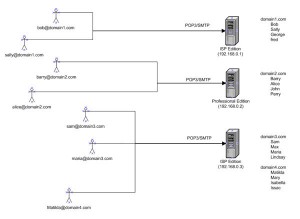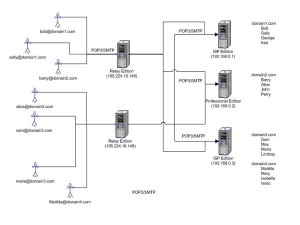AutoCluster Overview
AutoCluster is a unique feature of FTGate servers. This advanced feature allows for the automatic configuration of a network of servers while allowing a pooled front end server array to manage the marshalling of connections between the servers.
FTGate AutoCluster offers a powerful way in which an ISP or larger organization can optimize their network and protect against the potential disaster of having a single point of failure disable their whole network. In an Auto-Clustered distributed cluster system, no single failure will disable the whole network and you can be confident that your customers will see the best possible service that can be offered.
This feature will be primary interest to ISPs or multi-domain corporate networks.
Advantages of AutoCluster
- Distributed Clustering
- Trivial installation
- Dynamic auto configuration
- Load sharing
- Transparent to customer
- Distributed spam reduction
- No single point of failure
- Low cost – FTGate Relay Edition server free with each FTGate ISP edition server
How AutoCluster works
Let us assume that an ISP has three servers that they are using to host the accounts for domain1.com, domain2.com and domain3.com. In a non-AutoCluster network each member of each domain must configure their mail clients to connect to the specific IP address, as shown below.
In this scenario all the filtering and processing of mail for a domain is performed by the specific server for that domain. If for some reason the IP of the server needs to change, or the mailboxes need to be moved to a different server with more capacity, then each client connecting to the server must update their mail client settings. If the server suffers a hardware failure then it will not be possible to replace it without network reconfiguration and customer disruption. Also if there is a requirement for backup MX servers then these must be configured for each server and if spam is to be reduced the filtering for each MX server configured individually.
If we replace the network above with an AutoCluster front end, things change considerably.
In an AutoCluster network each of the Relay Edition servers takes a dual role. Its primary role is to act as an MX relay for all the domains on the network and the secondary role is to act as a connection Proxy. This means that all the clients are configured to connect to a fixed IP list regardless of the server on which their mail is hosted.
AutoCluster is further enhanced by a unique feature by which it can automatically configure itself for all the users in the network pool. Thus adding a new domain or user to any back end server causes all the relays to be updated with the user lists for each machine. This allows the Relay Edition servers to dynamically reject email for addresses that are not valid on the back end servers and thus protect against network overload caused by dictionary attacks and reduce the amount of spam that is accepted by the whole network. An additional advantage of the AutoCluster system is that the main process load of virus scanning can be performed on the front end servers thus adding another layer of protection to the back end servers.


